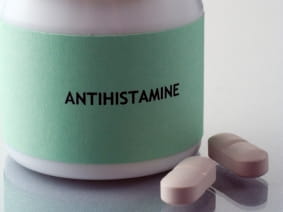Safe Use of Antihistamines

The Bottom Line
Antihistamines are medicines to treat allergic reactions to pollen, dust, pet dander, foods, and medications. Antihistamines are found in many different forms for children and adults: liquids, tablets, creams, nasal sprays, and eye drops. Finding the best antihistamine for your symptoms can take a while. In the meantime, never take too much!

The Full Story
Are you one of the 50 million people in the U.S. with allergies? Do you suffer with coughing, sneezing, itchy and watery eyes, a runny nose, and a scratchy throat? If so, you may take antihistamines to treat your symptoms.
Allergens are things that cause an allergic reaction. Examples include pollen, dust, pet dander, even foods or medications. When an allergen enters your body, your body releases histamine. Histamine causes the familiar symptoms of allergies. Antihistamines relieve symptoms by blocking histamine.
A lot of different antihistamines are available. They fill the counters and prescription shelves at your local drug store. New ones seem to appear all the time. Antihistamines are found in many different forms for children and adults: liquids, tablets, creams, nasal sprays, and eye drops. They are also common ingredients in over-the-counter cold and cough products, along with decongestants, pain relievers and cough suppressants.
There are two main classes of antihistamines. They work in different ways and have different side effects.
- The older first-generation antihistamines are also called sedating antihistamines. They cause much more drowsiness and fatigue than the newer antihistamines. (In fact, these antihistamines sometimes are used as sleeping pills.) Side effects can include dizziness, poor coordination, dry mouth, nausea and vomiting, blurred vision, and trouble urinating. One antihistamine in this group is diphenhydramine (Benadryl®). Others are brompheniramine (Bromfed®, Dimetapp®), hydroxyzine (Vistaril®, Atarax®) and meclizine (Antivert®).
- The newer second and third-generation or non-sedating antihistamines are used much more frequently. Usually, they don't cause drowsiness. Antihistamines in this group include cetirizine (Zyrtec®), loratadine (Claritin®), and fexofenadine (Allegra®). In high doses, these antihistamines can still cause drowsiness and rapid heart rate.
Some antihistamines may work better than others for your symptoms. It can be hard to find the one that works just right. If you are desperate (and still coughing and sneezing and itching), you may be tempted to take too much. BUT - it can be dangerous to take extra antihistamines. More is not better.
- Do NOT "double-up" on a dose.
- Do NOT take a dose sooner than you're supposed to.
- Do NOT take two different antihistamines at the same time.
- Instead, talk to your doctor or pharmacist if you have trouble finding a drug that works well for your allergy symptoms.
Antihistamines are safe when used as directed. When used improperly, serious effects can occur. Be aware:
- Taking too much can be harmful for children and adults. Be sure to check the label for the correct dose.
- Some people abuse the sedating antihistamines trying to get “high”. This can cause seizures and hallucinations.
- Some antihistamines are combined with pain medicine. Taking another pain medicine at the same time could cause an overdose.
- Some antihistamines are combined with decongestants. Taking another decongestant at the same time could cause an overdose.
Follow these guidelines when using antihistamines:
- Read labels carefully.
- Some antihistamines should not be used for children. Make sure you are using a children’s product when giving antihistamines to your child.
- Some antihistamines can interact with other medicines. Check with your doctor or pharmacist or call Poison Control and speak with a Specialist if you have questions.
- Different products may contain the same ingredients. Taking them at the same time can be dangerous.
- Take (or give) the right dose.
- Lock antihistamines up high, where children can't reach them. Children can drink liquid antihistamines, swallow too many pills, or even eat antihistamine creams. Severe poisoning can occur this way.
Not sure which antihistamine is best for you? For your child? Call your doctor or pediatrician. If you took too much, or gave too much to your child, use the webPOISONCONTROL® online tool for guidance or call Poison Control right away at 1-800-222-1222. Whether you use the online tool or call, you'll be able to determine if treatment is needed.
Serkalem Mekonnen, RN, BSN, MPH
Certified Specialist in Poison Information
Poisoned?
Call 1-800-222-1222 or
Prevention Tips
Follow these guidelines when using antihistamines.
- Read labels carefully.
- Some antihistamines should not be used for children.
- Some antihistamines can interact with other medicines. Check with your doctor or pharmacist if you have questions.
- Different products may contain the same ingredients. Taking them at the same time can be dangerous.
- Take (or give) the right dose.
- Lock antihistamines up high, where children can't reach them. Children can drink liquid antihistamines, swallow too many pills, or even eat antihistamine creams. Severe poisoning can occur this way.
This Really Happened
Case 1: A 13-month-old 22-lb boy was discovered by his mom playing with an empty bottle of Unisom® gelcaps (diphenhydramine 25 mg). She estimated that about 20 gelcaps (1,000 mg of diphenhydramine) were missing, an extremely toxic amount even for a large adult. The child had a seizure at home before emergency medical services (EMS) arrived. He had three more seizures en route to the hospital and was given intramuscular sedation by EMS. The child arrived at the emergency room within 45 minutes of being found with the bottle. Shortly after arrival in the emergency room he seized again and was given intravenous sedation, which ended the seizure, and he seemed to be stable.
The child was admitted to the pediatric ICU for observation. About 3.5 hours after he was found with the medication bottle, he began having frequent seizures and developed a very fast heart rate and an abnormal heart rhythm. His blood pressure dropped and he had a high fever. A tube was placed to help him breathe. Many different medications were given, but he continued to deteriorate despite medical treatment, 11 hours after he swallowed the diphenhydramine.
Because of the particular hospital's experience treating an adult patient with a diphenhydramine overdose with hemodialysis (blood flows through a special filter that removes poisons, and the clean blood is returned to the body), a team of physicians, including a toxicologist, decided that hemodialysis was a reasonable life-saving option for this small child.
He underwent two hemodialysis treatments. After the first, his seizures and abnormal heart rhythm resolved, though his heart rate was still slightly fast. After a second hemodialysis treatment, he was stable. The breathing tube was removed, and he was able to come off sedation and the medications that had been supporting his blood pressure. The child was transferred to a regular medical floor on hospital day 3. He was discharged to home without any further problems on hospital day 4.
Case 2: Both the mom and dad of a toddler gave the child a teaspoon of Children's Benadryl within twenty minutes of each other. Though the 25 mg total dose of diphenhydramine was more than he needed for his allergies, it was not enough to cause a serious problem based on his age and weight. Poison Control recommended giving him fluids to drink and observing at home. The child was fine.
Case 3: An adult male was prescribed hydroxyzine (Atarax®), an antihistamine that causes drowsiness, to help him sleep. He took twice the dose recommended by his physician due to trouble sleeping. Instead of becoming drowsy, he was quite restless. He called Poison Control in the middle of the night and was advised that antihistamines may sometimes cause restlessness instead of drowsiness, especially in higher doses. Poison Control recommended that he speak with his doctor about an alternative medication for sleep.
For More Information
Allergy Facts and Figures (AAFA)
Allergy medicines for children (AAP)
References
Simons FER, Simons KJ. Histamine and H1-antihistamines: celebrating a century of progress. J Allergy Clin Immunol. 2011;128:1139-50.Poisoned?
Call 1-800-222-1222 or
Prevention Tips
Follow these guidelines when using antihistamines.
- Read labels carefully.
- Some antihistamines should not be used for children.
- Some antihistamines can interact with other medicines. Check with your doctor or pharmacist if you have questions.
- Different products may contain the same ingredients. Taking them at the same time can be dangerous.
- Take (or give) the right dose.
- Lock antihistamines up high, where children can't reach them. Children can drink liquid antihistamines, swallow too many pills, or even eat antihistamine creams. Severe poisoning can occur this way.
This Really Happened
Case 1: A 13-month-old 22-lb boy was discovered by his mom playing with an empty bottle of Unisom® gelcaps (diphenhydramine 25 mg). She estimated that about 20 gelcaps (1,000 mg of diphenhydramine) were missing, an extremely toxic amount even for a large adult. The child had a seizure at home before emergency medical services (EMS) arrived. He had three more seizures en route to the hospital and was given intramuscular sedation by EMS. The child arrived at the emergency room within 45 minutes of being found with the bottle. Shortly after arrival in the emergency room he seized again and was given intravenous sedation, which ended the seizure, and he seemed to be stable.
The child was admitted to the pediatric ICU for observation. About 3.5 hours after he was found with the medication bottle, he began having frequent seizures and developed a very fast heart rate and an abnormal heart rhythm. His blood pressure dropped and he had a high fever. A tube was placed to help him breathe. Many different medications were given, but he continued to deteriorate despite medical treatment, 11 hours after he swallowed the diphenhydramine.
Because of the particular hospital's experience treating an adult patient with a diphenhydramine overdose with hemodialysis (blood flows through a special filter that removes poisons, and the clean blood is returned to the body), a team of physicians, including a toxicologist, decided that hemodialysis was a reasonable life-saving option for this small child.
He underwent two hemodialysis treatments. After the first, his seizures and abnormal heart rhythm resolved, though his heart rate was still slightly fast. After a second hemodialysis treatment, he was stable. The breathing tube was removed, and he was able to come off sedation and the medications that had been supporting his blood pressure. The child was transferred to a regular medical floor on hospital day 3. He was discharged to home without any further problems on hospital day 4.
Case 2: Both the mom and dad of a toddler gave the child a teaspoon of Children's Benadryl within twenty minutes of each other. Though the 25 mg total dose of diphenhydramine was more than he needed for his allergies, it was not enough to cause a serious problem based on his age and weight. Poison Control recommended giving him fluids to drink and observing at home. The child was fine.
Case 3: An adult male was prescribed hydroxyzine (Atarax®), an antihistamine that causes drowsiness, to help him sleep. He took twice the dose recommended by his physician due to trouble sleeping. Instead of becoming drowsy, he was quite restless. He called Poison Control in the middle of the night and was advised that antihistamines may sometimes cause restlessness instead of drowsiness, especially in higher doses. Poison Control recommended that he speak with his doctor about an alternative medication for sleep.
